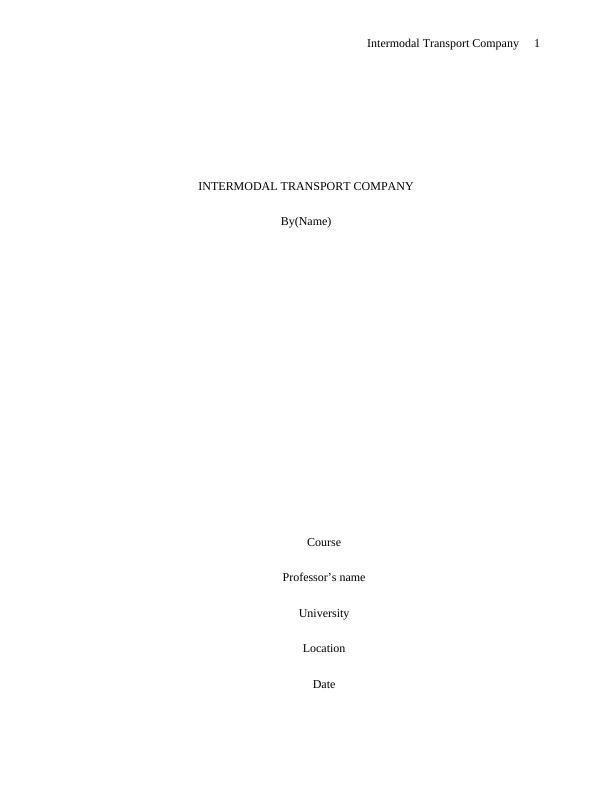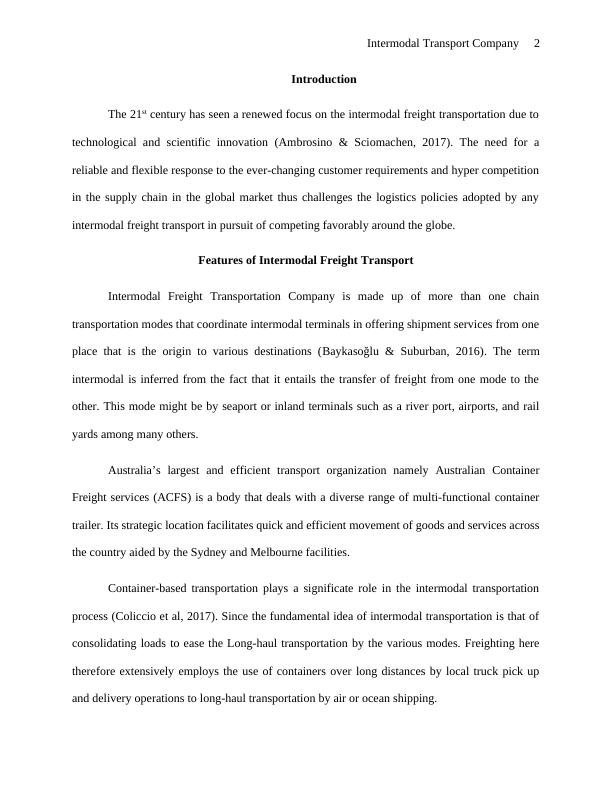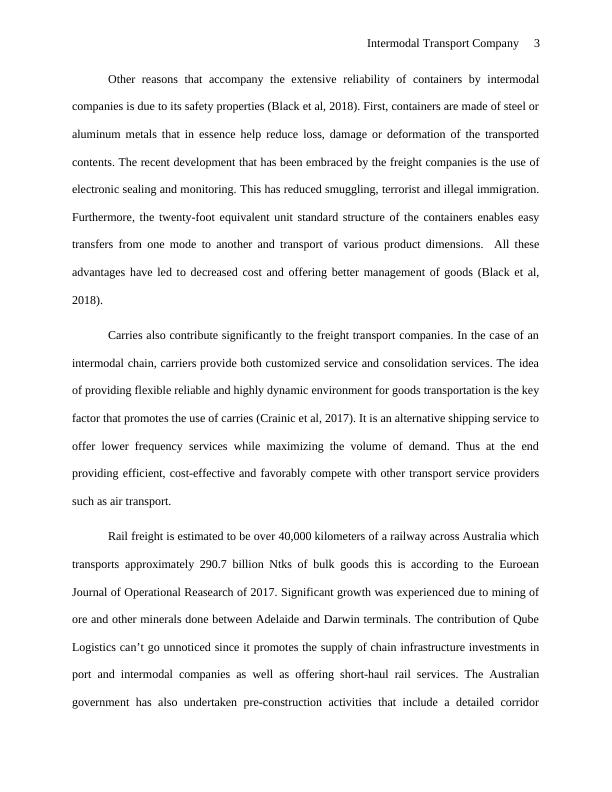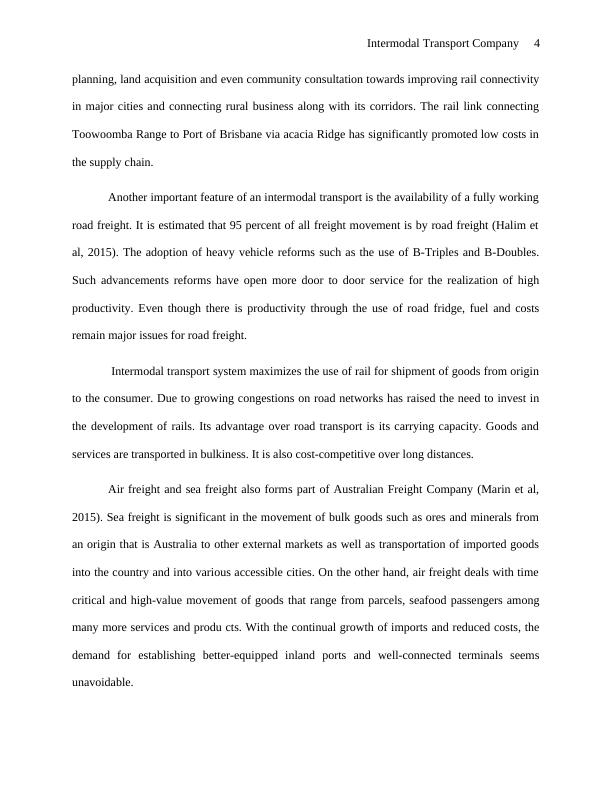Intermodal Transport Company: Features, Challenges, and Logistics Strategies
Added on 2023-06-12
13 Pages3448 Words430 Views
Intermodal Transport Company 1
INTERMODAL TRANSPORT COMPANY
By(Name)
Course
Professor’s name
University
Location
Date
INTERMODAL TRANSPORT COMPANY
By(Name)
Course
Professor’s name
University
Location
Date

Intermodal Transport Company 2
Introduction
The 21st century has seen a renewed focus on the intermodal freight transportation due to
technological and scientific innovation (Ambrosino & Sciomachen, 2017). The need for a
reliable and flexible response to the ever-changing customer requirements and hyper competition
in the supply chain in the global market thus challenges the logistics policies adopted by any
intermodal freight transport in pursuit of competing favorably around the globe.
Features of Intermodal Freight Transport
Intermodal Freight Transportation Company is made up of more than one chain
transportation modes that coordinate intermodal terminals in offering shipment services from one
place that is the origin to various destinations (Baykasoğlu & Suburban, 2016). The term
intermodal is inferred from the fact that it entails the transfer of freight from one mode to the
other. This mode might be by seaport or inland terminals such as a river port, airports, and rail
yards among many others.
Australia’s largest and efficient transport organization namely Australian Container
Freight services (ACFS) is a body that deals with a diverse range of multi-functional container
trailer. Its strategic location facilitates quick and efficient movement of goods and services across
the country aided by the Sydney and Melbourne facilities.
Container-based transportation plays a significate role in the intermodal transportation
process (Coliccio et al, 2017). Since the fundamental idea of intermodal transportation is that of
consolidating loads to ease the Long-haul transportation by the various modes. Freighting here
therefore extensively employs the use of containers over long distances by local truck pick up
and delivery operations to long-haul transportation by air or ocean shipping.
Introduction
The 21st century has seen a renewed focus on the intermodal freight transportation due to
technological and scientific innovation (Ambrosino & Sciomachen, 2017). The need for a
reliable and flexible response to the ever-changing customer requirements and hyper competition
in the supply chain in the global market thus challenges the logistics policies adopted by any
intermodal freight transport in pursuit of competing favorably around the globe.
Features of Intermodal Freight Transport
Intermodal Freight Transportation Company is made up of more than one chain
transportation modes that coordinate intermodal terminals in offering shipment services from one
place that is the origin to various destinations (Baykasoğlu & Suburban, 2016). The term
intermodal is inferred from the fact that it entails the transfer of freight from one mode to the
other. This mode might be by seaport or inland terminals such as a river port, airports, and rail
yards among many others.
Australia’s largest and efficient transport organization namely Australian Container
Freight services (ACFS) is a body that deals with a diverse range of multi-functional container
trailer. Its strategic location facilitates quick and efficient movement of goods and services across
the country aided by the Sydney and Melbourne facilities.
Container-based transportation plays a significate role in the intermodal transportation
process (Coliccio et al, 2017). Since the fundamental idea of intermodal transportation is that of
consolidating loads to ease the Long-haul transportation by the various modes. Freighting here
therefore extensively employs the use of containers over long distances by local truck pick up
and delivery operations to long-haul transportation by air or ocean shipping.

Intermodal Transport Company 3
Other reasons that accompany the extensive reliability of containers by intermodal
companies is due to its safety properties (Black et al, 2018). First, containers are made of steel or
aluminum metals that in essence help reduce loss, damage or deformation of the transported
contents. The recent development that has been embraced by the freight companies is the use of
electronic sealing and monitoring. This has reduced smuggling, terrorist and illegal immigration.
Furthermore, the twenty-foot equivalent unit standard structure of the containers enables easy
transfers from one mode to another and transport of various product dimensions. All these
advantages have led to decreased cost and offering better management of goods (Black et al,
2018).
Carries also contribute significantly to the freight transport companies. In the case of an
intermodal chain, carriers provide both customized service and consolidation services. The idea
of providing flexible reliable and highly dynamic environment for goods transportation is the key
factor that promotes the use of carries (Crainic et al, 2017). It is an alternative shipping service to
offer lower frequency services while maximizing the volume of demand. Thus at the end
providing efficient, cost-effective and favorably compete with other transport service providers
such as air transport.
Rail freight is estimated to be over 40,000 kilometers of a railway across Australia which
transports approximately 290.7 billion Ntks of bulk goods this is according to the Euroean
Journal of Operational Reasearch of 2017. Significant growth was experienced due to mining of
ore and other minerals done between Adelaide and Darwin terminals. The contribution of Qube
Logistics can’t go unnoticed since it promotes the supply of chain infrastructure investments in
port and intermodal companies as well as offering short-haul rail services. The Australian
government has also undertaken pre-construction activities that include a detailed corridor
Other reasons that accompany the extensive reliability of containers by intermodal
companies is due to its safety properties (Black et al, 2018). First, containers are made of steel or
aluminum metals that in essence help reduce loss, damage or deformation of the transported
contents. The recent development that has been embraced by the freight companies is the use of
electronic sealing and monitoring. This has reduced smuggling, terrorist and illegal immigration.
Furthermore, the twenty-foot equivalent unit standard structure of the containers enables easy
transfers from one mode to another and transport of various product dimensions. All these
advantages have led to decreased cost and offering better management of goods (Black et al,
2018).
Carries also contribute significantly to the freight transport companies. In the case of an
intermodal chain, carriers provide both customized service and consolidation services. The idea
of providing flexible reliable and highly dynamic environment for goods transportation is the key
factor that promotes the use of carries (Crainic et al, 2017). It is an alternative shipping service to
offer lower frequency services while maximizing the volume of demand. Thus at the end
providing efficient, cost-effective and favorably compete with other transport service providers
such as air transport.
Rail freight is estimated to be over 40,000 kilometers of a railway across Australia which
transports approximately 290.7 billion Ntks of bulk goods this is according to the Euroean
Journal of Operational Reasearch of 2017. Significant growth was experienced due to mining of
ore and other minerals done between Adelaide and Darwin terminals. The contribution of Qube
Logistics can’t go unnoticed since it promotes the supply of chain infrastructure investments in
port and intermodal companies as well as offering short-haul rail services. The Australian
government has also undertaken pre-construction activities that include a detailed corridor

Intermodal Transport Company 4
planning, land acquisition and even community consultation towards improving rail connectivity
in major cities and connecting rural business along with its corridors. The rail link connecting
Toowoomba Range to Port of Brisbane via acacia Ridge has significantly promoted low costs in
the supply chain.
Another important feature of an intermodal transport is the availability of a fully working
road freight. It is estimated that 95 percent of all freight movement is by road freight (Halim et
al, 2015). The adoption of heavy vehicle reforms such as the use of B-Triples and B-Doubles.
Such advancements reforms have open more door to door service for the realization of high
productivity. Even though there is productivity through the use of road fridge, fuel and costs
remain major issues for road freight.
Intermodal transport system maximizes the use of rail for shipment of goods from origin
to the consumer. Due to growing congestions on road networks has raised the need to invest in
the development of rails. Its advantage over road transport is its carrying capacity. Goods and
services are transported in bulkiness. It is also cost-competitive over long distances.
Air freight and sea freight also forms part of Australian Freight Company (Marin et al,
2015). Sea freight is significant in the movement of bulk goods such as ores and minerals from
an origin that is Australia to other external markets as well as transportation of imported goods
into the country and into various accessible cities. On the other hand, air freight deals with time
critical and high-value movement of goods that range from parcels, seafood passengers among
many more services and produ cts. With the continual growth of imports and reduced costs, the
demand for establishing better-equipped inland ports and well-connected terminals seems
unavoidable.
planning, land acquisition and even community consultation towards improving rail connectivity
in major cities and connecting rural business along with its corridors. The rail link connecting
Toowoomba Range to Port of Brisbane via acacia Ridge has significantly promoted low costs in
the supply chain.
Another important feature of an intermodal transport is the availability of a fully working
road freight. It is estimated that 95 percent of all freight movement is by road freight (Halim et
al, 2015). The adoption of heavy vehicle reforms such as the use of B-Triples and B-Doubles.
Such advancements reforms have open more door to door service for the realization of high
productivity. Even though there is productivity through the use of road fridge, fuel and costs
remain major issues for road freight.
Intermodal transport system maximizes the use of rail for shipment of goods from origin
to the consumer. Due to growing congestions on road networks has raised the need to invest in
the development of rails. Its advantage over road transport is its carrying capacity. Goods and
services are transported in bulkiness. It is also cost-competitive over long distances.
Air freight and sea freight also forms part of Australian Freight Company (Marin et al,
2015). Sea freight is significant in the movement of bulk goods such as ores and minerals from
an origin that is Australia to other external markets as well as transportation of imported goods
into the country and into various accessible cities. On the other hand, air freight deals with time
critical and high-value movement of goods that range from parcels, seafood passengers among
many more services and produ cts. With the continual growth of imports and reduced costs, the
demand for establishing better-equipped inland ports and well-connected terminals seems
unavoidable.

End of preview
Want to access all the pages? Upload your documents or become a member.
Related Documents
Understanding Intermodal Transportation: ISO Containers, Swap Bodies, Piggyback, and Rolling Roads in Europelg...
|15
|3718
|500
Intermodal Transportation and Logistics Management Strategies: A Case Study of Pakistan Intermodal Limitedlg...
|13
|3785
|103
Intermodal Benefits and Featureslg...
|13
|3145
|214
Key challenges in the value chain of container transportlg...
|15
|3022
|24
Challenges and Strategies for Qube Logistics in New South Waleslg...
|12
|3292
|153
Logistic Management Intermodal | Assignmentlg...
|12
|3417
|35
